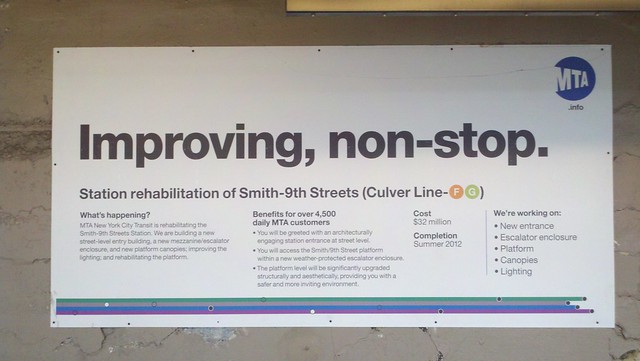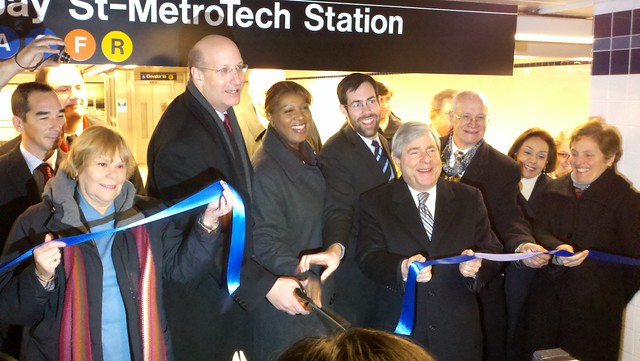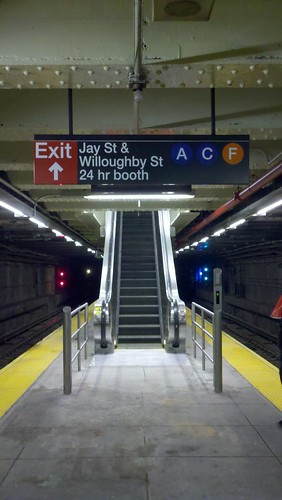 As Phase 1 of the Second Ave. Subway inches toward the finish line, the date for revenue service remains, according to the latest MTA documents, December 2016. We’ll witness at least two more Presidential elections before the trains roll past 63rd St. and Lexington and up Second Ave. Yet, the one question I most often field from readers concerns the identity of the Second Ave. Subway. Now that the Q heads to Astoria and doesn’t terminate at 57th St., will the MTA reroute it to serve as the Second Ave. Subway or will they revive another letter — perhaps the W — to signify and celebrate the new service?
As Phase 1 of the Second Ave. Subway inches toward the finish line, the date for revenue service remains, according to the latest MTA documents, December 2016. We’ll witness at least two more Presidential elections before the trains roll past 63rd St. and Lexington and up Second Ave. Yet, the one question I most often field from readers concerns the identity of the Second Ave. Subway. Now that the Q heads to Astoria and doesn’t terminate at 57th St., will the MTA reroute it to serve as the Second Ave. Subway or will they revive another letter — perhaps the W — to signify and celebrate the new service?
For now, my general answer is “don’t worry about it.” So much can happen in six years that it’s not worth pondering the potential fate of the Astoria-bound Q train. Maybe the MTA will revive the W. Maybe the MTA will reshuffle service into and out of Astoria to ensure that the Q runs from Second Ave. and East 96th St. to Coney Island. Maybe some other Broadway-based service pattern will emerge. Today, that’s the least of the authority’s concerns.
Yet, these questions make me think there’s something more to the train line than just a decal letter on a subway stop and a colored line on a map. As we ride, we form connections with train lines for better or worse. For my entire life, I’ve lived near the West Side IRT trains. Growing up, my local station was the 96th St. on the 1/2/3, and today, I’m just a stone’s throw away from Grand Army plaza — where a green interloper in the shape of a 4 takes up precious real estate on the station entrance sign.

At Grand Army Plaza, a Crown Heights-bound 3 train zooms away. (Photo by Benjamin Kabak)
I’ve always considered the 2 to be my favorite train. When I was growing up, the old redbirds that used to roll along the 2 captured my attention. As a kid waiting to go to Yankee Stadium from the Upper West Side, I would peer into the tunnel hoping to catch a glimpse of the headlights on the 2 — but not the bullet signs on the 3 — so we could be on our way north.
Today, the rolling stock for the 2 consists of the not-so-new R142s, and those are distinctive for the bright red beacon at the top. Generally, the cars are well lit and well air conditioned. They don’t have those too-narrow bucket seats that make you feel as though you’ve encroached far beyond the limits of your neighbor’s personal space, and that express ride up the West Side from Chambers to 96th is among the fatest in the system.
Growing up, I was always skeptical of those other trains. The lines along Central Park West were the far-off ones that we never rode, and the stations nearest us — 86th St., 96th St. — were empty local stops. Other trains — the mysterious F, the J/M/Z, the East Side’s 4/5/6 — were other people’s trains. They weren’t mine. What did I care what happened to them?
Well, 22 years ago this past weekend, something big happened to them for on December 11, 1988. I didn’t know it at the time but for millions of riders who weren’t me, the subways shifted. Trains that used to go over the Manhattan Bridge didn’t; trains that used to run to one part of Queens were re-routed to others. The K train disappeared completely, and a new Z train materialized.

The August 1994 subway map reveals service patterns lost to the sands of time.
Over the next 16 years, straphangers would find their favorite — or just their most convenient — routes changed. In fact, in 2004, Brooklynites long used to the Brighton Beach-bound D trains were in for a shock. The D — which had run down the Brighton Line for nearly 40 years — had become the B, and the B had become the D. Overnight, everything changed, and a Beastie Boys reference had become anachronistic with the stroke of a pen. That’s how fleeting subway routing can be.
New York City subway riders tend to view the map as immovable. It has always looked as it does today, and service patterns have always been what they are today. Does anyone remember the V train? Does anyone remember life before the 6th Ave. M? And where did that W train go anyway? The trains come and go. We form bonds; they become preferred and then favorites; and then we forget about them when they’re gone.
One day later this decade, if all goes according to plan, Astorians will see their service patterns shifted again. The Q will go up Second Ave., and it will become the favorite line of a young Upper East Sider. He or she will never know what life is like without the Second Ave. Subway because it will have always been there, a gleaming beacon of permanent change in a system that shifts whether we notice it or not.











 (Rockaway Park Shuttle)
(Rockaway Park Shuttle)



 Norman Seabrook, head of the New York City Correction Officers’ Benevolent Association and one of the MTA Board’s most vocal pro-labor advocates, has not bee reappointed to his position. Instead, Gov. David Paterson, in the waning days of his time in Albany, Charles G. Moerdler, a partner the lawfirm of Stroock & Stroock & Lavan with no transportation background and extensive real estate experience to the board. It is a move that seemingly speaks volumes of the short-term future of the MTA’s relationship with labor.
Norman Seabrook, head of the New York City Correction Officers’ Benevolent Association and one of the MTA Board’s most vocal pro-labor advocates, has not bee reappointed to his position. Instead, Gov. David Paterson, in the waning days of his time in Albany, Charles G. Moerdler, a partner the lawfirm of Stroock & Stroock & Lavan with no transportation background and extensive real estate experience to the board. It is a move that seemingly speaks volumes of the short-term future of the MTA’s relationship with labor. 
 The Straphangers Campaign does not think 2010 was a banner year for public transit in New York City. The rider advocacy group released their annual list of Top Tens today, and while they managed to put together a list of the top ten best stories of the year, their top ten worst are more sobering. The list includes fare hikes, service cuts and ever-increasing budget gaps, and it portends rough seas ahead for the MTA.
The Straphangers Campaign does not think 2010 was a banner year for public transit in New York City. The rider advocacy group released their annual list of Top Tens today, and while they managed to put together a list of the top ten best stories of the year, their top ten worst are more sobering. The list includes fare hikes, service cuts and ever-increasing budget gaps, and it portends rough seas ahead for the MTA. 